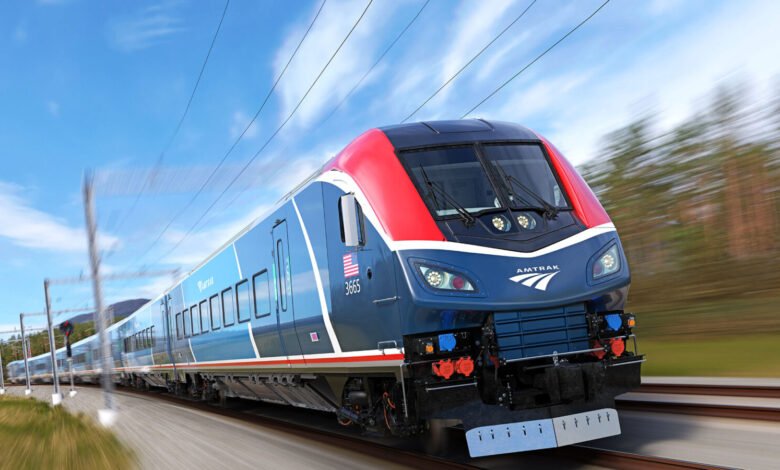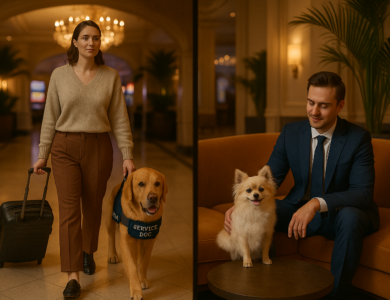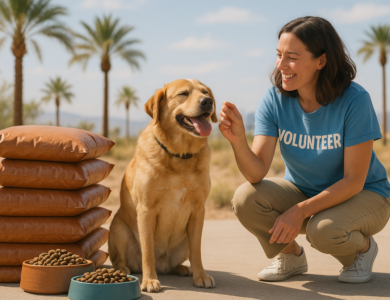We may earn a commission when you click on links across our website. This does not influence our opinions — learn more.
Can Amtrak Get You and Your Dog to Las Vegas?

Traveling with a dog is always a balance between convenience and comfort, and trains often seem like the sweet spot — no TSA lines, no cargo holds, just a seat, a window, and a calmer pace. Over the past decade, Amtrak has leaned into that idea with a pet program designed for small dogs and cats, and it now works well on thousands of journeys each year. But if your destination is Las Vegas, there is an important wrinkle that most travelers do not discover until they start planning: the city has no Amtrak rail service. The last passenger train serving Las Vegas, the Desert Wind, was discontinued in 1997, and the downtown station closed along with it. Today, the city is served only by an Amtrak Thruway bus connection, and that is where the real limitation appears — pets are not permitted on Thruway buses.
So, can you still take your dog on an Amtrak journey to Las Vegas? Yes, but it requires some planning. The strategy is to ride the train with your dog to a nearby station, usually in Kingman or Barstow, and then complete the final leg of the trip by car. The key is understanding Amtrak’s pet rules, how the Las Vegas “gap” affects logistics, and which local workarounds make the trip smooth for both you and your dog.
Amtrak’s Pet Rules
Amtrak’s pet program is deliberately narrow, and knowing the boundaries up front makes everything easier. Your dog must be small — the combined weight of the dog and the carrier cannot exceed 20 pounds. The carrier itself must fit under the seat, with maximum external dimensions of 19 inches by 14 inches by 10.5 inches. Hard and soft carriers are both allowed, provided they are leak-proof and ventilated, and your dog must be able to sit, stand, and turn around comfortably inside. Pets must remain in the carrier at all times — on the platform, in the station, onboard, and even at your seat.
There are also time limits. Trips must be seven hours or less, including any connections, and pets are only allowed in Coach. The one exception is on the Acela, which permits pets in Business Class since there is no Coach option. First Class and sleeper cars are off-limits everywhere. Amtrak charges a small pet fee per segment, typically between $25 and $29, and each train only permits a limited number of pet reservations. That means booking early is essential.
It is worth noting that Amtrak does not impose breed restrictions within its pet program. The gatekeepers are the weight and carrier requirements. Service animals, on the other hand, are a separate category under the Americans with Disabilities Act. They are not considered pets, do not have weight or carrier restrictions, can ride in any class, and travel free of charge. They must, however, be under control and housebroken. Emotional support animals are treated like pets under Amtrak policy and must follow the same weight, carrier, and reservation rules.
No Direct Amtrak to Las Vegas
Here is the central challenge. Las Vegas no longer has passenger rail service, only an Amtrak Thruway bus stop downtown, identified by station code LVS. The stop exists to connect travelers from nearby rail lines into the city. On paper, this looks like a convenient option — ride the train as far as possible, transfer to the Thruway coach, and roll straight into Las Vegas. In reality, it is a non-starter for anyone with a pet.
Amtrak’s policy is unambiguous: pets are not permitted on Thruway buses. The contractors that operate these coaches follow the rule strictly. This means that if you are traveling with a pet (not a service animal), you cannot use the official bus connections from Kingman, Barstow, Bakersfield, or any other city into Las Vegas.
The workaround is to treat the nearest rail station as your endpoint, then switch to a pet-friendly mode of travel for the last portion of the trip. For almost everyone, this means arranging a one-way rental car that you can drop off in Las Vegas. It requires an extra step, but it is also straightforward: book a pet slot on a train segment within the seven-hour limit, arrange for a rental car upon arrival, and you have effectively bridged the gap that the buses cannot cover.
Nearest Stations
Most travelers use Kingman, Arizona as their pivot point. Kingman sits on the Southwest Chief line and is about 100 miles from Las Vegas, roughly a two-hour drive along U.S. Highway 93. The train ride from Los Angeles to Kingman takes about six hours, which fits neatly under Amtrak’s seven-hour pet limit. Kingman also has enough rental car coverage to make the handoff practical.
Barstow, California is another option on the same line. It is about 155 miles from Las Vegas via Interstate 15, which means a longer drive but still manageable. This option can make sense for travelers starting in Southern California, where connections to Barstow may be more convenient. Needles, California is closer in miles, about 120, but it is a smaller stop with fewer services, and most pet travelers find Kingman to be more reliable.
Bakersfield, California also appears in Amtrak searches because the San Joaquins terminate there, with Thruway buses continuing on to Las Vegas. This can work well for passengers without pets. With a dog, however, it is much less practical. The bus portion does not allow pets, and the car leg from Bakersfield to Las Vegas is long enough to be cumbersome unless your trip is already focused on California’s Central Valley.
Booking With a Pet
Think of booking a pet reservation as securing a limited ticket within your main ticket. You cannot simply show up at the station. Each train only sets aside a handful of pet slots, and they often sell out — particularly on weekends and holidays. The seven-hour cap includes connections, which is why a single Los Angeles to Kingman segment works so well for pet travel to Las Vegas: you stay within the time limit, avoid the bus, and make one clean transfer.
Because Amtrak charges the pet fee per segment, multi-leg journeys with a dog can become more expensive and difficult to schedule. The more transfers you add, the more time your dog must spend inside the carrier. For that reason, a single rail segment ending at Kingman or Barstow is the most efficient option. When booking, look for the “Add Pet” option — if you do not see it, the train’s pet slots are already full. Finally, remember that delays count toward the seven-hour rule. It is best to pad your schedule with some buffer time in case a departure runs late.
Carriers and In-Cabin Rules
For many first-time Amtrak travelers with pets, the carrier becomes the make-or-break detail of the trip. It is not just a formality — it is your dog’s entire world for the duration of the train ride. Amtrak enforces its size limits strictly, and the carrier must not exceed 19 inches by 14 inches by 10.5 inches. More importantly, your dog needs to fit comfortably inside. They should be able to sit upright, turn around, and lie down without being cramped against the walls.
If you are on the fence about whether your carrier is appropriate, err on the side of comfort and begin practice well before travel day. Start by having your dog spend short periods in the carrier at home while you are nearby, gradually building up to longer “sessions.” A helpful training trick is to simulate the travel experience by placing the carrier under a chair, zipping it closed, and playing ambient train sounds from your phone or computer. The more familiar the carrier feels, the less stressful the actual journey will be.
Inside, line the bottom with an absorbent pad and bring at least one spare. Add a small blanket, towel, or even a worn T-shirt that carries your scent — this can make a huge difference in calming your dog. Be prepared for the rules to be enforced without exception: no laps, no letting your dog peek out, no holding them during the trip. The expectation is that they remain fully contained from station to station.
It is also important to remember that Amtrak crews have the authority to deny boarding if an animal is disruptive or distressed. Excessive barking, whining, or visible discomfort can result in being turned away at the station. This is why practice is so important: a calm, well-conditioned dog is far more likely to be welcomed on board without issue.
Trip Length and Class Restrictions
Amtrak’s seven-hour trip limit for pets may feel restrictive, but it is not arbitrary. The rule exists as a compromise — long enough to allow many common regional trips, but short enough to keep animals safe, minimize noise and accidents, and prevent trains from turning into rolling kennels.
On practical terms, this means you cannot take your dog on a cross-country Amtrak journey. Multi-day trips that would require sleeper cars are off-limits, since pets are not allowed in sleepers or First Class accommodations. The Acela corridor is the only notable exception: because Acela has no Coach class, pets are permitted in Business Class on those routes. For trips involving Las Vegas, though, you should plan on riding in standard Coach.
The restriction also affects your ability to leave your seat. Since your dog must remain in the carrier under the seat, you cannot leave them unattended to wander to the café car or observation lounge. If you are traveling with a companion, the best strategy is to alternate breaks so one person stays with the dog while the other fetches food or drinks. If you are traveling solo, stock up on snacks, meals, and water before you board so you will not need to leave your seat for long periods.
Delays are another consideration. Because the seven-hour limit includes actual travel time, a significant delay could put you over the limit. It is wise to choose itineraries comfortably under the seven-hour threshold, particularly if you know you will be traveling through busy corridors or regions where delays are common.
Stations and Boarding With a Pet
Stations are one of the easiest points to manage with a pet — provided you plan ahead and arrive early. At staffed stations, you will check in your pet reservation and often be asked to sign a brief release form. At unstaffed stations, the conductor will check you in at the platform, but it is still your responsibility to have the pet booking confirmed on your ticket.
Keep in mind that boarding often involves handling the carrier yourself. Crew members may help, but you should be prepared to lift and maneuver the carrier one-handed while carrying your own bag with the other. Practicing this at home can make the process smoother.
At the station and on the platform, the rules are the same: your pet must remain in the carrier at all times. Do not assume you can let them stretch out on the platform or carry them in your arms — Amtrak policies prohibit both. Once on board, your best bet is to immediately slide the carrier under the seat and arrange your belongings around it, keeping the aisle clear.
Some trains have designated “pet rows,” which conductors may assign to consolidate passengers with animals. If not, you will be seated in standard Coach alongside other travelers. During longer operational stops, such as fuel breaks or crew changes, you may be tempted to step off for a quick relief walk. Always ask the conductor first. Most stops are not long enough to make this practical, and trains will depart on schedule whether you are back or not.
The Thruway Bus Problem
The single largest barrier to reaching Las Vegas with your dog on Amtrak is the Thruway bus connection. These buses, which Amtrak contracts to cover gaps in its rail network, do not allow pets under any circumstances. There are no exceptions for small dogs in carriers. The rule applies across all routes, including the vital Kingman-to-Las Vegas and Bakersfield-to-Las Vegas links.
The same restriction holds true for most other intercity bus operators such as Greyhound and FlixBus. Service animals are allowed, but pets are not. For many travelers, this discovery comes late in the planning process and causes last-minute frustration.
The most realistic solution is to arrange a car for the last leg of the journey. A one-way rental car is by far the most common choice. Pick up your car at the Kingman or Barstow station and return it at one of the many Strip or airport locations in Las Vegas. This method is reliable, predictable, and gives you control over your dog’s comfort. Alternatives like asking a friend for a pickup, pre-arranging a pet-friendly rideshare, or hiring a specialty pet taxi are possible but much less dependable.
Planning the Final Leg
The drive into Las Vegas is short and straightforward, but desert conditions require extra care. From Kingman, the drive is roughly 100 miles along U.S. Highway 93, usually taking about two hours. From Barstow, the drive follows Interstate 15 for about 155 miles, which usually means two and a half hours on the road. Both routes are simple to follow but can be brutally hot in summer.
Plan ahead by booking your one-way rental car in advance. Airport-based rental branches often offer the best hours and largest inventories. Bring a seat cover or blanket to protect the upholstery, and pack a “car kit” for your dog that includes water, a collapsible bowl, waste bags, a towel or wipes, and a few treats. If traveling alone, plan a single, efficient fuel and bathroom stop where you can safely keep your dog in air-conditioned comfort. If traveling with a companion, trade off so your dog is never left unattended in a hot car.
Once you reach Las Vegas, check into your hotel and immediately locate the designated pet relief area. Many large hotels require a long walk across casino floors and multiple towers, so knowing the route in advance can prevent stressful situations when your dog is eager to get outside.
Pet-Friendly Hotels in Las Vegas
One of the best things about Las Vegas is how straightforward pet lodging has become. Almost every major hotel family on the Strip has a formal pet policy, which makes planning much easier once you get past the train and bus limitations.
On the Caesars side, the PetStay program covers Caesars Palace, Paris, Planet Hollywood, Flamingo, Harrah’s, Horseshoe, The LINQ, and The Cromwell. These properties generally allow up to two dogs with a maximum weight of 50 pounds each. Nightly pet fees vary depending on the hotel, but most range between $50 and $100. Rooms are designated specifically for guests with dogs, and staff can direct you to outdoor relief areas when you check in.
MGM Resorts also maintains a broad pet program across its properties, including Bellagio, Aria, Mandalay Bay, Vdara, Park MGM, New York-New York, Luxor, and Excalibur. Their policies usually allow two dogs with a combined weight limit of up to 100 pounds. Fees tend to scale with the tier of the hotel — luxury properties charge more, while mid-tier resorts are more affordable.
The Cosmopolitan is widely considered the most pet-friendly hotel on the Strip. Its policy allows up to two dogs with no weight limit, and it charges a flat pet fee rather than scaling by size. Even better, the property has two designated dog relief areas on site, making it one of the most convenient places to stay if you are walking your dog multiple times per day.
Wherever you choose, always call ahead after booking to confirm the hotel’s current pet policy, request a designated pet-friendly room, and ask exactly where the closest relief areas are located. In large resorts, this can save you significant time and stress after a long travel day.
Rules for Dogs in Las Vegas
Visitors are often surprised by how specific Las Vegas’ rules for dogs can be, especially on the Strip itself. By city ordinance, dogs are not allowed on the Las Vegas strip between noon and 5:00 a.m. Service animals are exempt, but for pets, this means you can only take your dog for a walk along the Strip in the early morning hours between 5:00 a.m. and noon. Early walks are actually a blessing in disguise, since mornings are cooler and sidewalks are less crowded.
Beyond the Strip restriction, standard leash laws apply throughout the city. Dogs must remain on a leash in all public areas, and off-leash time is only permitted in designated dog parks. Inside hotels, pets are usually restricted to designated pathways — typically from guest rooms to exits and relief areas. Casino floors, restaurants, pools, and spas are all off-limits to pets under local health codes.
For off-leash exercise, consider visiting a local dog park. Sunset Park, near the airport, has large fenced areas, shaded benches, and plenty of space for your dog to run. Charlie Frias Park, west of the Strip, is another good choice with separate areas for small and large dogs. Downtown offers fewer options, so if you are staying near Fremont Street, a taxi or rideshare to a park will save time.
Getting Around Town With a Dog
Transportation logistics can make or break a pet-friendly trip. Fortunately, Las Vegas offers several workable options.
Uber Pet is widely available and usually the most convenient choice. For a small surcharge, you are matched with drivers who accept animals. It is courteous to send a quick message to your driver to confirm and to bring a blanket or towel to protect the car seats. Standard taxis often accept dogs at the discretion of the driver — just let the attendant at the taxi stand know you need a pet-friendly cab.
Public transit is less flexible. The RTC bus system allows small pets if they are fully enclosed in carriers, but the Monorail and most hotel trams do not permit pets. Always assume “service animals only” when it comes to transit options outside of standard rideshare and taxis.
For travelers who want guaranteed service, Las Vegas has dedicated pet taxi companies. These operate like couriers for animals and can provide direct transportation to the vet, groomer, or even the airport. They cost more than rideshare but can be worth it if you want certainty and reliability.
Heat and Paw Safety
The desert heat is not just uncomfortable for dogs — it can be dangerous. Pavement temperatures can soar above 140°F on sunny afternoons, easily hot enough to burn a dog’s paws in seconds. The safest routine is to walk your dog before sunrise or in the early morning, use artificial turf relief areas during the hottest parts of the day, and reserve exercise for evening once the concrete cools.
A simple test is to place your hand on the pavement. If you cannot hold it there comfortably for five seconds, it is too hot for your dog’s paws. Booties can offer some protection if your dog will tolerate them, but they do not solve the problem of overall heat stress. Always carry water and a collapsible bowl, and never leave your dog in a vehicle unattended. Even in moderate weather, cars heat up quickly, and Nevada law penalizes leaving animals in unsafe conditions.
Inside hotels, keep the room cool and set up a comfortable space for your dog away from direct sunlight. Build downtime into your schedule. Dogs tire quickly in the heat, and letting them rest in an air-conditioned room will make the rest of your trip much smoother.
Packing Checklist
Think of your packing list as building a mobile “home base” for your dog. Essentials include:
- An Amtrak-compliant carrier (with at least one spare absorbent pad).
- A flat, sturdy leash (shorter is safer in crowds).
- A collapsible water bowl and bottled water.
- A small towel or wipes for quick cleanups.
- Dog food in a sealable container and measured treats for travel days.
- A collapsible crate if your hotel requires crating during housekeeping.
- Digital or printed vaccination records, including rabies.
- Extra doses of any medication your dog needs.
- A flashlight for early-morning or late-night relief walks.
- Booties if your dog uses them, and something from home (like a favorite toy or blanket) to provide comfort in unfamiliar environments.
Sample Itineraries
Los Angeles to Kingman to Las Vegas (Small Dog):
Take the Southwest Chief from Los Angeles Union Station to Kingman, Arizona (about six hours). Add your pet reservation early to secure a spot. On arrival, pick up a one-way rental car, give your dog a brief shaded relief break, and drive two hours into Las Vegas. Your dog’s total “carrier time” stays under the seven-hour limit, and the overall trip takes about eight to nine hours.
San Diego or Orange County to Barstow to Las Vegas:
If your origin connects more naturally to Barstow, ride the Southwest Chief there instead. From Barstow, the drive to Las Vegas takes about two and a half hours via Interstate 15. The process is the same: secure your pet’s spot on the train, rent a car, and handle the final leg by road.
Both itineraries avoid the Thruway bus problem entirely while keeping within Amtrak’s pet travel rules.
Quick Reference Guide
- Weight limit: Dog plus carrier must weigh 20 pounds or less.
- Carrier size: 19″ x 14″ x 10.5″ maximum; must fit under seat.
- Trip length: Seven hours or less (connections included).
- Travel class: Coach only (Acela allows Business Class; no First or sleepers).
- Pet fee: Usually $25–$29 per segment.
- Las Vegas service: No direct trains; Amtrak Thruway buses prohibit pets.
- Best pivot stations: Kingman, AZ (≈100 miles from Las Vegas) or Barstow, CA (≈155 miles).
- Final leg: Rental car is the most practical option.
- Strip rules: Dogs allowed only between 5:00 a.m. and noon; must be leashed.
- Heat safety: Walk before sunrise, protect paws, never leave dogs in vehicles.
Bottom Line
You can absolutely travel to Las Vegas with your dog using Amtrak — it just takes a little more planning. Since the city has no rail service and Amtrak’s Thruway buses do not allow pets, the winning formula is to ride a short pet-friendly train segment to Kingman or Barstow, then cover the final stretch by car. This two-step plan keeps you within Amtrak’s rules, avoids bus restrictions, and makes the trip smooth for your dog.
Once in Las Vegas, the city is surprisingly pet-friendly. Hotels across the Strip — from budget chains to five-star resorts — offer clear policies, and designated relief areas make day-to-day routines manageable. With smart planning, respect for the desert climate, and a pet-first mindset, you and your dog can enjoy the best of both worlds: the calm of the train journey and the energy of Las Vegas waiting at the end.



